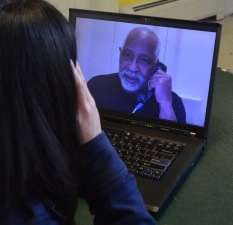Jails Introduce Glitchy, Pricey Video Visitation Systems—and Get Families to Use Them By Banning In-Person Visits
A different sort of telecom monopoly

More than 500 jails and prisons around the country have started implementing a new sort of visitation system, one where inmates interact with visitors not in the same room or through glass but via video screens. When accessed remotely, such systems offer obvious advantages to many prisoners and their families: They make it easier to stay in touch even with people who live far away, and they often fit more flexibly into a work or school schedule as well. The systems are far glitchier than Skype or FaceTime—and can be expensive to use—but it's easy to see why many people behind bars might rather have the technology than not have it.
Unfortunately, a new study from the Prison Policy Initiative reports that video visits are mostly catching on not in remotely located state facilities but in county jails, which are less likely to be far from home. Worse still, many of those jails are eliminating the inmates' other options for contact with the outside world:
Given that prisons hold people convicted of more serious crimes, one might expect that if any facility were going to ban contact visits and require visitation via onsite video terminals, it would be state prisons. However, state prisons understand that family contact is crucial for reducing recidivism, and burdening individuals with extensive travel only to visit an incarcerated loved one by video screen is particularly counterproductive. As Illinois Department of Corrections Spokesman Tom Shaer explained to the St. Louis Post-Dispatch, the state had no plans to eliminate in-person visits: "I can't imagine the scenario in which someone would travel to a prison and then wish to communicate through a video screen rather than see a prisoner face-to-face."
In contrast, county jails confine people who are generally not far from home, and the majority are presumed innocent while they attempt to pay bail or await trial. The 40% of people in jail who have been convicted are generally serving a relatively short sentence for misdemeanor crimes. Despite the fact that jails should be particularly conducive to in-person visits, most jails have replaced contact visits with through-the-glass visits. And when jails implement video visitation, they typically replace through-the-glass visiting booths with a combination of onsite and remote paid video visitation.
The study's authors suggest that there is a deliberate effort "to drive people from what was traditionally a free service towards an inferior, paid replacement." One company that provides prisons with the video visitation services, Securus, explicitly requires a ban on face-to-face visits in its contracts.
There's much more in the paper, including a detailed discussion of how video visitation systems affect families (and attorneys, who have complained about "the lack of privacy and the technological glitches that prevent them from building rapport with their clients"). I disagree with a few of the policy recommendations at the end—I don't think, for example, that the FCC should be creating new technical quality standards for the prison-video companies—but there are a lot of good ideas for lawmakers too. To read the whole thing, go here.


Show Comments (9)